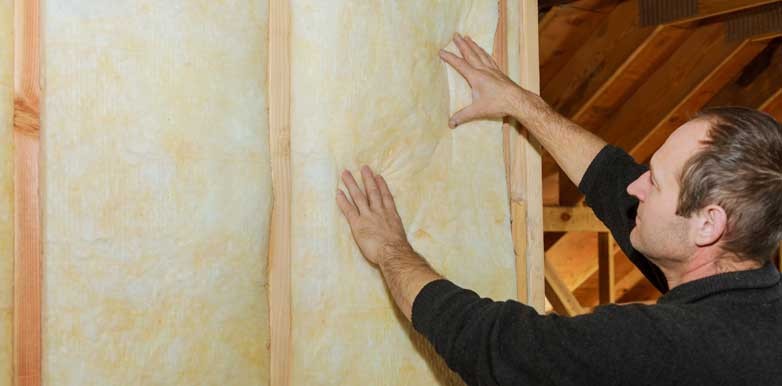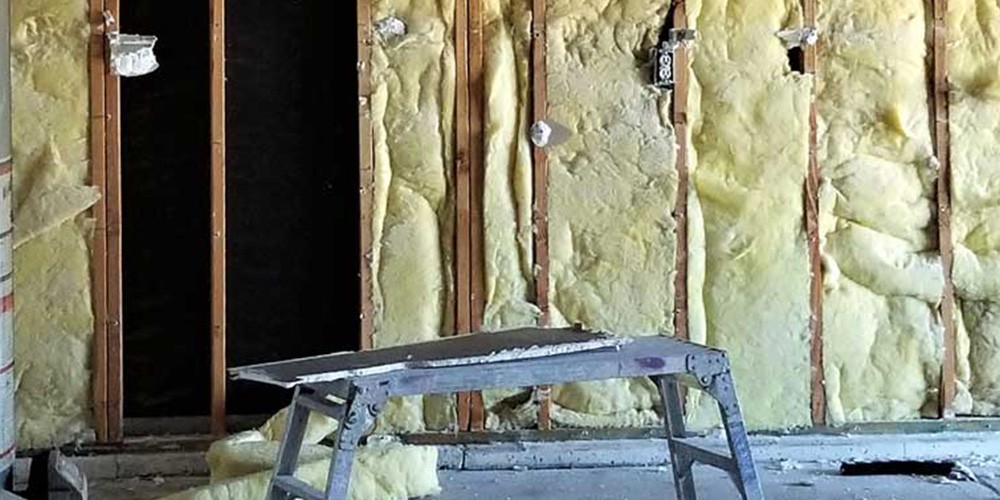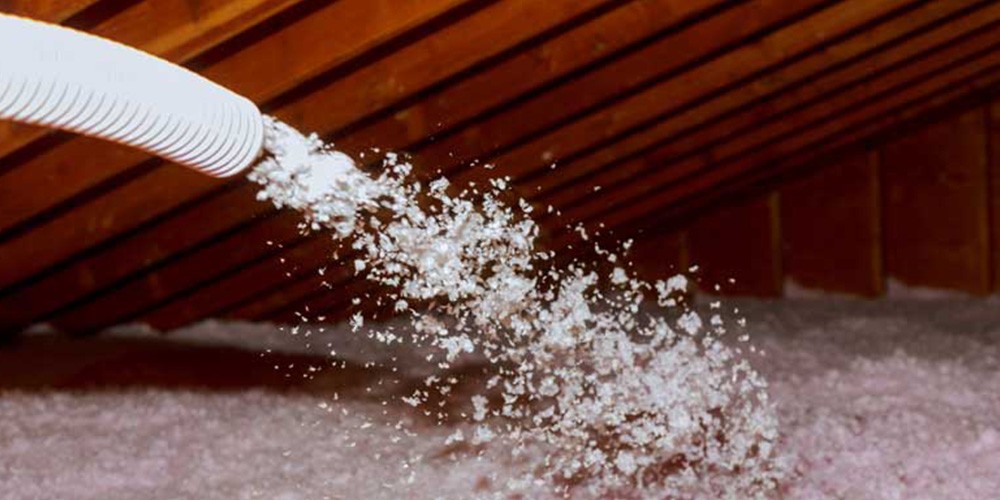Types Of Insulation Guide

To maintain a warm, energy efficient house, insulation is essential and a good source of insulation will also help to keep a building from overheating in the summer. Without insulation any heat that you pump into your home via a fire or gas heating system will quickly escape leading to high energy bills. You might be surprised to know that on average you will lose 25% of heat through the roof of your home, 35% through uninsulated walls and gaps around windows and a further 10% through the floor.
The addition of insulation can decrease these percentages dramatically and will also stop any damage occurring to your house as a result of mould or rot. Installing insulation into outbuildings is also of great benefit, and will not only prevent any damage occurring to the outbuilding which could lead to infestation from rodents or insects but it will also keep whatever you’re storing in there in good condition and perhaps more importantly provide a usable space for you right through the winter months rather than just in summer.
It’s important to look at what U-Value the type of insulation that you use provides. You can find out all about U-Values here but put simply, the lower the U Value, the better. It’s also advised to leave a ventilated gap between roof tiles and the insulation that you apply so that moisture can vent away.
There are a number of different types of insulation available and many can be used for roofs, floors and walls. This article will run through the differences between the different types and what they are best used for.
Benefits Of Insulation
As much as a quarter of heat can be lost in an uninsulated home, most of which will transfer through your roof. As you can guess, this will leave it a virtual icebox in the winter and allow for the hot summer sun to more easily penetrate your loft. Insulation, at its core, works to prevent this. Slowing down heat transfer to ensure a comfortable temperature all year round.
Considering most insulation, properly installed, can last upwards of four decades you’ll also find it a superb investment - limiting your reliance on gas or electrical heating and keeping costs as low as they can be. After just a few years, it may well have already paid for itself and then some.
Insulation doesn’t just help you, though. It can also be a great boon for the environment, after all, around 14% of UK greenhouse gas emissions come from excess energy use in homes – namely the need to heat them. Installing improved insulation then, is a great step towards our goal of being a carbon-neutral nation.
What is Your Roof Type?
Whilst shopping for insulation, the first thing to keep in mind is your roof type. Is it pitched or flat and are you working to achieve cold roof or warm roof configuration? The answers to these questions will be a great help when narrowing down your options.
Pitched
When insulating a pitched roof, you’ll have to decide whether you are looking to insulate the joists (cold roof) or insulate the rafters (warm roof). The difference between the two is quite drastic, as is the budget – however it's important not to confuse one for the other.
A cold roof is when insulation simply covers the floor space. This means you can have your pick of the litter when it comes to materials – from mineral or wool rolls to loose fills. In most cases, you’ll find them easy to install with some options even available with added sound-proofing properties. That being said, cold roofs are predominately designed for storage spaces. Not only will the floor be covered but any heat above the insulation will be able to escape with ease – this means that your loft will be cold, hardly suitable for living in.
A warm roof then, is essential when converting your loft to a bedroom or shared living space as the insulation will instead be installed between and beneath the rafters. Typically, you will want insulation of a higher quality to ensure the space is comfortable and that means more rigid boards, slabs, or even versatile multi-foil. These will often be tacked to your rafter and can be cut to size to ensure a perfect fit.
Types of Insulation
Insulation Boards
Insulation boards have one of the best u-values out of all the insulation options, with leading brand Kingspan having a U-value of just 0.022.
Coming in large boards, that can be easily cut to size using a handsaw, the boards can be pushed into place and are ideal for floors, ceilings and walls. They’re a wonderful choice for insulating a garden building or conservatory roof but can be more cumbersome if you are trying to insulate a larger area such as an attic, although, because of their wonderfully low u-value they are still often used for bigger projects.
There’s a choice of thicknesses available which is brilliant if you have a specific space to fill, between joists for example, and they have an amazing life expectancy with many brands expected to last the lifetime of the building it is put in. They're resistant to water vapour and fire and although they are one of the more expensive options, with a 2400mm by 1200mm board costing £66.71, they are a superb insulative material.
Insulation Rolls
Insulation rolls are made of glass mineral wool and, dependent on the thickness, typically have a u-value of around 0.044. They also have brilliant sound absorption qualities which is one of their big selling points.
Often chosen for the combined sound and thermal insulation capabilities that they provide insulation rolls are popular in residential buildings. The rolls can be used in walls, floors and roofs and are also a particularly brilliant choice if you have a long area to fill. For example, if you had a wide attic that you wanted to insulate, laying long rows down using an insulation roll would be much quicker and easier than using numerous insulation boards to fill the same space.
Sheep's Wool
Wool insulation, supplied in rolls, is one of the most versatile choices available. Easy to install and suitable not only for roofs but often floors and walls as well. Sheep’s wool takes this a step further by also being one of the most environmentally friendly options – manufactured from a fully sustainable source and able to absorb as much as 30% of its own weight in water without sacrificing performance.
Mineral Wool
Mineral wool, on the other hand, is a phenomenal acoustic insulator. Made from a mixture of stone and silica with porous and non-directional fibres serving to absorb sound – perfect for homes near busy roads or train stations. Like Sheep’s wool, it also boasts a fantastic thermal efficiency, with these fibres woven together in a candy-floss pattern to trap air in make-shift internal pockets.
Glass Wool
Glass wool is perhaps the most flexible of the bunch, able to be compressed across large areas and uneven surfaces. Thanks to its superb cost-effectiveness and performance, it tends to be a popular choice for numerous residential and commercial properties - favoured especially for its resistance to mould and vermin.
Insulation rolls are typically made from glass mineral wool and fire-retardant fibres and are non-combustible, preventing the spread of fire through your home. The glass mineral wool used in Knauf insulation rolls which you can purchase at Roofing Megastore is made from up to 80% of recycled materials, much of it coming from a glass recycling facility which is located next to the manufacturing plant making it a great eco-friendly choice too.
You can buy the rolls pre-cut in different thicknesses so that all you need to do is put them in place and each roll is incredibly lightweight making the process easy to complete. Per metre squared you can expect to pay around £1.65 for the Earth Wool making it one of the cheaper options for insulation.

Multifoil Insulation
A perfect DIY material, Multi-Foil insulation is some of the easiest to install and safest to handle – made from many layers of aluminium, thermo-foam and polypropylene. It is suitable for both pitched and flat roofs, able to be installed on floors, walls and lofts.
Multifoil insulation is made up of a combination of foil which reflects the heat back into the building and wadding to insulate. This combination creates a u-value of 0.04 which is the equivalent to mineral wool but the difference is that multifoil insulation is much thinner.
Because multifoil insulation is so thin (just 35mm thick!) it’s perfect for use if you want to be as space efficient as possible. For example if you have an attic that needs insulation but you don’t want to eat into the space then multifoil is ideal and can be used for walls, floors and roof. Coming in large sheets it’s also incredibly easy to install and can simply be stapled into place. As an example of price, you can purchase a Actis Hybris Insulation Roll to cover approximately 5.49m2 from £23.45 at Roofing Megastore.
Other benefits of multifoil insulation is that it’s airtight and moisture resistant and it works to maintain the temperature in your roof space in both summer and winter, retaining warmth in winter and preventing overheating in summer this, along with the fact that it’s so thin makes multifoil insulation perfect for insulating your conservatory or similar small space.
Insulation Slabs
Insulation Slabs (otherwise known as batts) are one of the most thermally efficient materials – commonly made from glass, mineral and sheep’s wool but moulded into rigid slabs instead of rolls. Insulation Slabs have an excellent u-value of just 0.034 and cost approximately £7.69 a squared metre. The resin bonded slabs are available in different sizes and thicknesses and are made up of naturally occurring renewable volcanic rock and are both sustainable and recyclable.
Insulation slabs are another product which offers both sound and thermal insulation, the slabs can be installed easily and when pushed together create a perfect friction fit, they can easily be pushed in between joists and are an easy option for a DIY project, ideal for loft and floor insulation they can also be used for walls.
Loose Fill Insulation
Loose Fill insulation is usually made of fiberglass or cellulose (recycled paper fiber combined with a fire retardant). One of the advantages of cellulose insulation is that it has the highest recycled content of any insulation available. It is usually blown or sprayed into place using pneumatic equipment and this makes it an ideal choice if you are using it for hard to reach areas.
It is commonly used for attics or wall cavities and another advantage is that it can be used over existing insulation. Loose Fill insulation can also be cheaper than some other options. However, there are disadvantages, often you will need to hire a contractor to apply the loose fill insulation and because it doesn’t create an air tight seal it doesn't always straight away and can drift and settle in different areas to what you want it, leaving the insulation uneven.
If you already have insulation laid and are thinking of putting some more on top of it loose fill insulation is an ideal option. You can find more information on the benefits of laying new on top of old insulation.

Sprayed Foam Insulation
If you’re considering paying a contractor to install your insulation you also have the option of sprayed foam insulation. Sprayed Foam Insulation is sprayed on in liquid form and gradually expands up to 100 times its initial size, filling cracks and holes as it does. Spray foam insulation, depending on the thickness that is applied, typically has a u-value of 0.40 with a thickness of 40mm and a u-value of 0.16 with a thickness of 150mm.
Spray foam is usually made up of polystyrene and can give off harmful fumes when applied and so it is recommended that only an experienced contractor apply it. Also, if applied incorrectly it can actually damage your homes structure so it’s best left for the professionals.
It can be a costly option and you can expect to pay anything up to £45 per metre squared to achieve the same u-value as what mineral wool would provide you with.
Is Fitting Insulation a DIY Job?
Whilst consulting with a professional is always the first recommended course of action, you may find yourself with enough spare time on your hands to attempt this job yourself. The good news is, that yes, depending on your chosen insulation fitting can be a simple job with the right preparations and precautions taken. Including appropriate PPE such as gloves and disposable masks. For more detailed installation information, please refer to our detailed guide.
Insulation Regulations
Part L of the building regulations set out all of the rules and recommendations to follow when installing or improving your loft insulation. It is essential, especially if you are converting your loft, you take into consideration the thickness of your insulation. New builds are required to have at least 270mm and, whilst this is not necessarily a requirement for other properties, it remains the recommended figure.
Remember, when converting a loft, you will also need to take planning permission into account. Whilst often this will fall into permitted development, if you are extending or altering your roof you will need to first notify your local authority.
More information
Whether you’re looking to replace, upgrade or fit new insulation you’ll find the right type of insulation material for you in our range of rolls, foils and slabs – manufactured from leading brands and with the support and advice of our award-winning customer service team just a phone call away. To get in touch, call us on 01295 565565 or ask your question using the chatbox below.